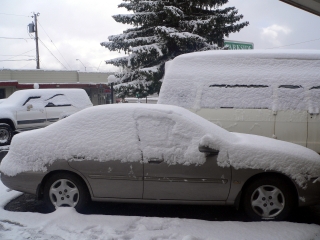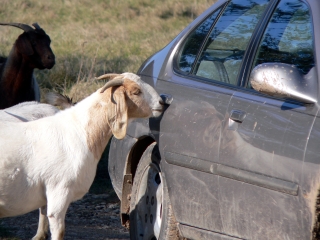Road Trip Tips:
Driving

As part of our initial planning, we estimated how many miles we would be driving each day as we drove from park site to park site, with detours to visit friends, family and other regional attractions. Sadly, our detours declined as gas prices increased. And increased. And increased.
A valid AAA membership is essential. Stopping at a local AAA to pick up more maps and Tour books were highlights of our days. The familiar letters in the distance made us giddy.
We recommend not relying on one map or atlas, but rather having several on hand to compare. If you can acquire NPS brochures for sites beforehand, their maps and directions are usually very helpful for navigation – not only to the site itself but around the surrounding area or town.
We made it a point not to drive at night, especially coming into large cities. Navigation gets tricky. It is harder to locate landmarks, traffic increases and by 6 pm, we are hungry and tired and cranky. Best to step out of the car. This rule, of course, does not include the drive to dinner or in search of the closest NTN trivia location.
Here are some additional recommendations that we learned on the road (sometimes the hard way):
Define your roles. Who is the driver? Who is the navigator? Will you take turns or will the driver and passenger seats take on the permanent imprints of each of your butts? We don’t recommend either option above the other; just make sure it is clear. If you are traveling solo, ignore this suggestion.
Learn when to multitask and when not to multitask. Long stretches of highway in the Dakotas are perfect for pulling out your computer and getting some writing done. Driving into an unknown city where two sets of eyes are needed for street signs and motel spotting is not the best time to decide you need to update the website. Common sense. We know. Well, we know now.

Be good to your car. By the end of our trip, the Altima was an equal partner in the C2C journey. We spoke to her, soothed her, and congratulated her for turns down tricky dirt roads which were never meant for a low-riding economy car. Because we were so close to our silent friend, we tried to keep her clean. Car washes are only a few bucks and everyone feels better afterwards. By keeping air in the tires and the oil changed often, we maximized fuel efficiency and minimized car-related incidents.
With the exception of a tiny parking-related scratch acquired in Philadelphia, the ‘Tima emerged from her 75,000+ miles journey unscathed. A new set of tires (thanks to a large rock which fell from a truck in front of us near Biloxi, Miss.) and new brake pads (thanks to Colorado) were the only adjustments needed.
Avoid eating in the car, when possible. Scents linger. When you are spending many hours in your car each day, you don’t really want to smell the fast food you ate three days ago. You will have enough aromas to contend with on a long-distance journey; why add unnecessary olfactory offense?
The times we disobeyed this rule of thumb, we paid for it. Ask Gab how easy it is to remove pancake syrup from a notebook, a daypack and the floor of the car. Ask Michael how many sesame seeds, poppy seeds and pieces of garlic and onion are on an Everything bagel. He would know, he tried to remove them all by hand as we settled down for a sleepless night in a high bear traffic area in Sequoia National Park.
Stash your stuff. While it is important to keep essential items like computers and cameras within reach while you are on the road, be sure they are never visible when you leave your vehicle. Take them with you or get them in the trunk before your reach a city or a park site. National park sites are not immune from crime. In fact, some Rangers will warn you about trailhead parking lots and camping locations where incidents of theft and vandalism have recently occurred. Why invite trouble?
Here is where we admit we did break our rule of keeping everything in the trunk when we got in the habit of keeping firewood for the next camping trip. We kept finding ourselves without dry wood when we really needed it, so we started to stash a few big logs in the backseat in case of emergency. We honestly think this acted as a crime deterrent. If someone feels a need to keep half-burnt logs in their backseat, do they really have anything that you want?
Have some of your own travel tips to share? We know you do! Go here and tell us. If we add your tip to www.usa-c2c.com, we'll send you a cool USA-C2C long sleeve T-shirt!
Driving Tip from Amy G. in Connecticut: Avoid speeding tickets and use cruise control on the highways--I love it!
Thanks, Amy! A T-shirt is coming your way!
|